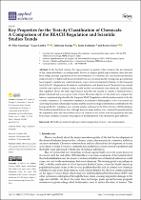Por favor, use este identificador para citar o enlazar este ítem:
https://repositorio.usj.es/handle/123456789/874
Registro completo de metadatos
| Campo DC | Valor | Lengua/Idioma |
|---|---|---|
| dc.contributor.author | Garralaga, María del Pilar | - |
| dc.contributor.author | Lomba Eraso, Laura | - |
| dc.contributor.author | Zuriaga Marco, Estefanía | - |
| dc.contributor.author | Giner Parache, Beatriz | - |
| dc.contributor.author | Santander Ballestín, Sonia | - |
| dc.date.accessioned | 2022-12-07T12:35:25Z | - |
| dc.date.available | 2022-12-07T12:35:25Z | - |
| dc.date.issued | 2022-11-17 | - |
| dc.identifier.uri | https://repositorio.usj.es/handle/123456789/874 | - |
| dc.description.abstract | In the last half century, the improvements in quality of life owing to the development of the chemical industry are indisputable. However, despite global improvements, there has also been a large increase in pollution at the environmental level and this has caused relevant harmful risks not only to wildlife and the environment but also to human health. In response, governments have begun to regulate and control chemicals to prevent environmental pollution. At the European level, REACH (Registration, Evaluation, Authorization, and Restriction of Chemicals) was created with the aim to protect human/animal health and the environment from chemicals. Additionally, this regulation shows the main experimental tests that are needed to classify a chemical from a physicochemical and toxicological point of view. The main objective of this study is to compare the tests or experiments stipulated by the European REACH regulation with the studies carried out by the scientific community. To obtain this comparison, an exhaustive bibliographic review was carried out, analyzing the physicochemical properties and the (eco)toxicological information established by the European REACH regulation and scientific articles published in the Web of Science (WOS) database. The results obtained indicate that, although there are many authors who conducted tests indicated by the regulation, there are others whose essays or studies are not in line with the regulation; this may be because, on many occasions, the purpose of the information to be obtained is quite different | en_US |
| dc.format.extent | 26 p. | en_US |
| dc.format.mimetype | application/pdf | en_US |
| dc.language.iso | eng | en_US |
| dc.publisher | MDPI | en_US |
| dc.relation.requires | adobe | en_US |
| dc.rights | Atribución 4.0 Internacional | * |
| dc.rights.uri | http://creativecommons.org/licenses/by/4.0/ | * |
| dc.subject | REACH | en_US |
| dc.subject | Environment | en_US |
| dc.subject | Physicochemical properties | en_US |
| dc.subject | Toxicity | en_US |
| dc.subject | Risk | en_US |
| dc.subject | Minimization | en_US |
| dc.title | Key Properties for the Toxicity Classification of Chemicals: A Comparison of the REACH Regulation and Scientific Studies Trends | en_US |
| dc.type | info:eu-repo/semantics/article | en_US |
| dc.identifier.doi | https://doi.org/10.3390/app122211710 | en_US |
| dc.rights.accessrights | info:eu-repo/semantics/openAccess | en_US |
| Aparece en las colecciones: | Artículos de revistas | |
Ficheros en este ítem:
| Fichero | Descripción | Tamaño | Formato | |
|---|---|---|---|---|
| Key Properties for the Toxicity Classification.pdf | 474,65 kB | Adobe PDF |  Visualizar/Abrir |
Este ítem está sujeto a una licencia Creative Commons Licencia Creative Commons

